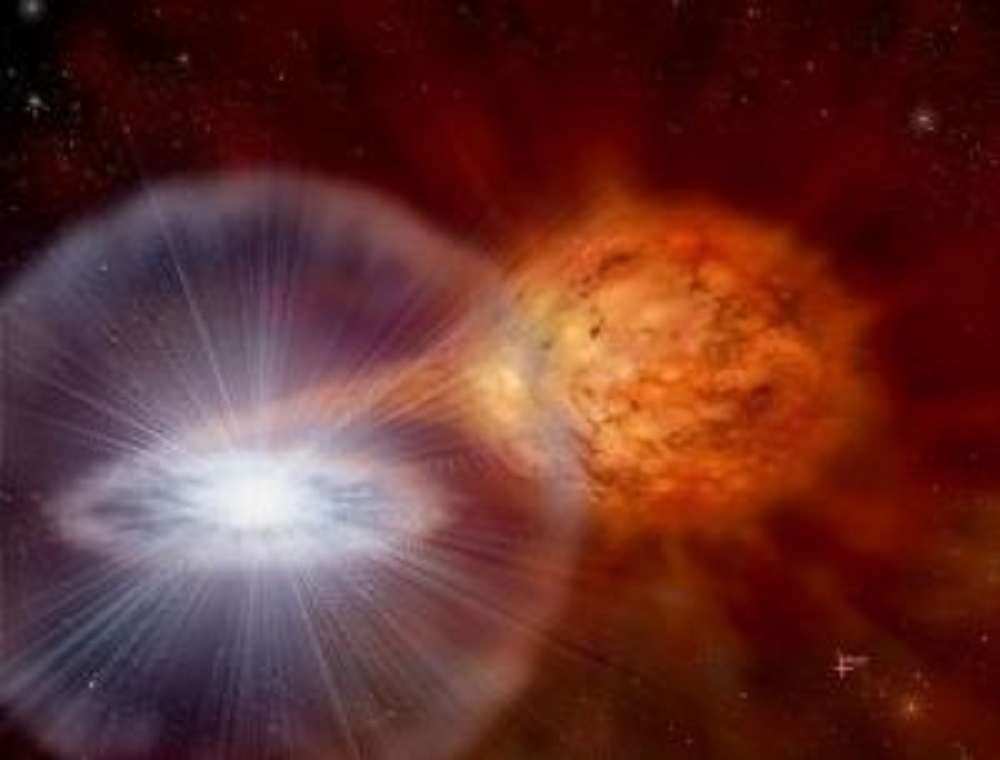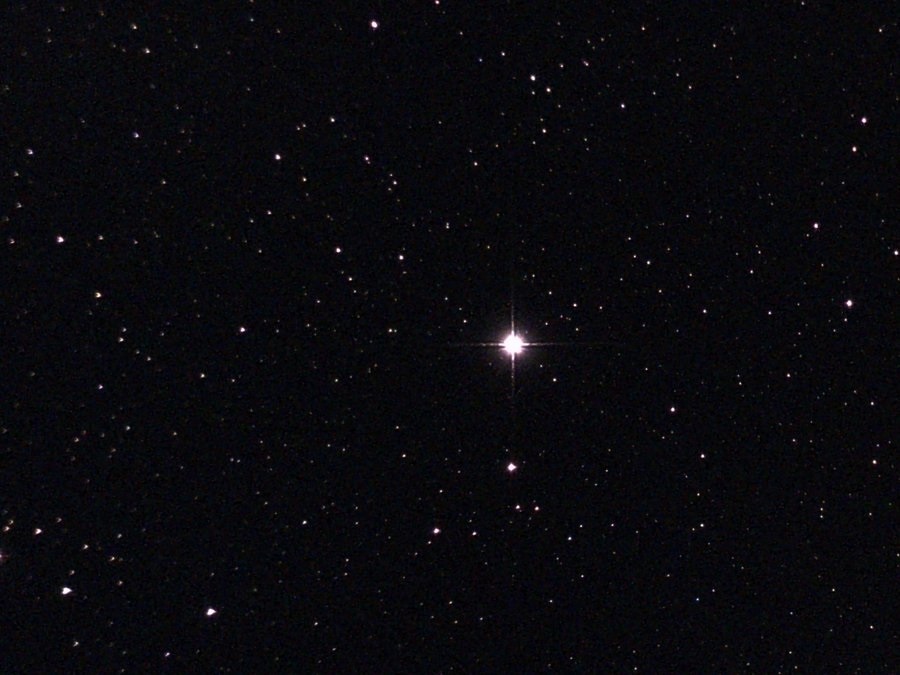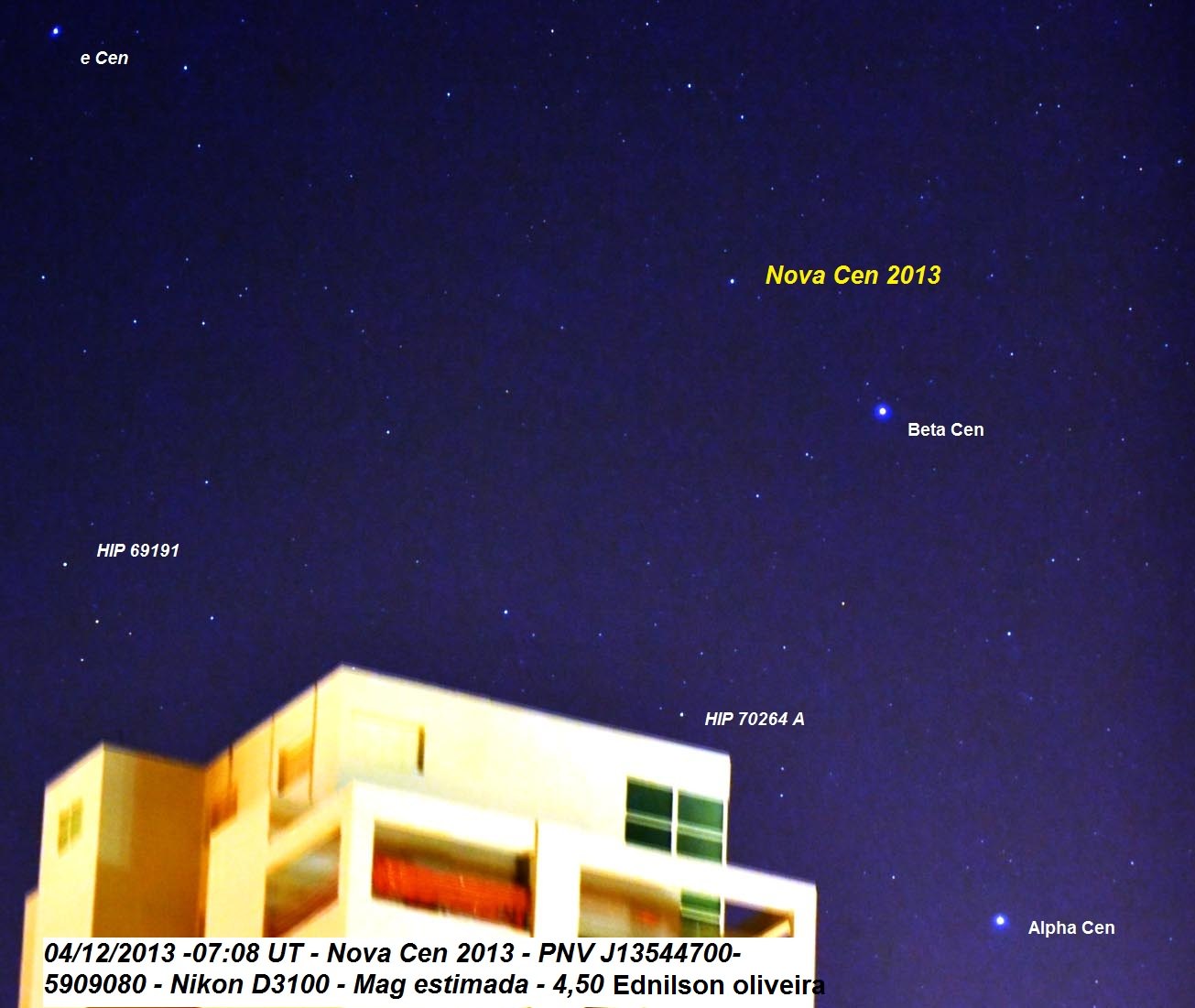I’ve seen some pretty incredible things using my eyes.. First off of course, is the stunning sight of a dark star filled sky, then there is the incredible sight of the Andromeda Galaxy 2.5 million light years away. Planets too can of course be seen as they slowly move across the sky but it’s a little more unusual to see something that reminds us the Universe changes. Well, we have an opportunity in just a few weeks time. The star T Corona Borealis (T CrB) will brighten about 1,500 times so it can be seen with the unaided eye. Miss it though and you will have to wait another 80 years!
Continue reading “We’re Now Just Weeks Away from a Stellar Explosion You Can See With Your Own Eyes”A Nova in the Making: Will T Coronae Borealis Pop in 2024?
If predictions are correct, a key outburst star could put on a show in early 2024.
If astronomers are correct, a familiar northern constellation could briefly take on a different appearance in 2024, as a nova once again blazes into prominence. The star in question is T Coronae Borealis, also referred to as the ‘Blaze Star’ or T CrB. Located in the corner of the constellation Corona Borealis or the Northern Crown, T CrB is generally at a quiescent +10th magnitude, barely discernible with binoculars… but once every 80 years, the star has flared briefly into naked eye visibility at around +2nd magnitude.
Continue reading “A Nova in the Making: Will T Coronae Borealis Pop in 2024?”Skywatcher’s Delight: Nova RS Ophiuchi in Outburst and Comet O1 Nishimura
The Perseids, a rare eruption of nova RS Ophiuchi and a challenging dawn comet round out an amazing week of skywatching.
It couldn’t have happened at a better time. While we’re all gearing up for the peak of the Perseid meteors this New Moon week on August 12th, two more astronomical events have given us a reason to step outside on warm August nights: the eruption of recurrent nova RS Ophiuchi, and the brief appearance of comet C/2021 O1 Nishimura.
Continue reading “Skywatcher’s Delight: Nova RS Ophiuchi in Outburst and Comet O1 Nishimura”This Star Has Been Going Nova Every Year, for Millions of Years
A nova star is like a vampire that siphons gas from its binary partner. As it does so, the gas is compressed and heated, and eventually it explodes. The remnant gas shell from that explosion expands outward and is lit up by the stars at the center of it all. Most of these novae explode about once every 10 years.
But now astrophysicists have discovered one remnant so large that the star that created it must have been erupting yearly for millions of years.
Continue reading “This Star Has Been Going Nova Every Year, for Millions of Years”A Naked Eye Nova Erupts in Centaurus
If you live in the southern hemisphere, the southern sky constellation of Centaurus may look a little different to you tonight, as a bright nova has been identified in the region early this week.
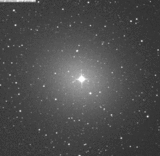
The initial discovery of Nova Centauri 2013 (Nova Cen 2013) was made by observer John Seach based out of Chatsworth Island in New South Wales Australia. The preliminary discovery magnitude for Nova Cen 2013 was magnitude +5.5, just above naked eye visibility from a good dark sky site. Estimates by observers over the past 24 hours place Nova Cen 2013 between magnitudes +4 and +5 “with a bullet,” meaning this one may get brighter still as the week progresses.
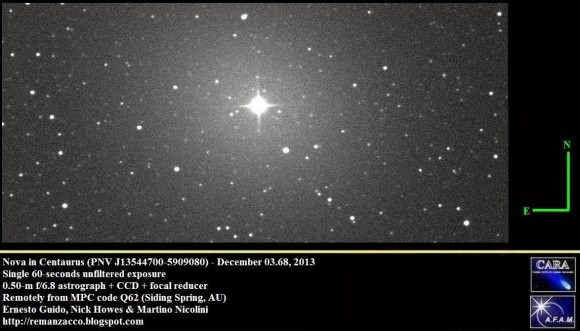
We first got wind of the discovery via the American Association of Variable Star Observers yesterday afternoon when alert notice 492 was issued. Established in 1911, the AAVSO is a great resource for info and a fine example of amateur collaboration in the effort to conduct real scientific observation.
Follow-up spectra measurements by Rob Kaufman in White Cliffs Australia and Malcolm Locke in Christchurch New Zealand demonstrated the presence of strong hydrogen alpha and hydrogen beta emission lines, the classic hallmark of an erupting nova. Like Nova Delphini 2013 witnessed by observers in the northern hemisphere, this is a garden variety nova located in our own galaxy, going off as seen along the galactic plane from our Earthbound perspective. A handful of galactic novae are seen each year, but such a stellar conflagration reaching naked eye visibility is worthy of note. In fact, Nova Cen 2013 is already knocking on the ranks of the 30 brightest novae observed of all time.
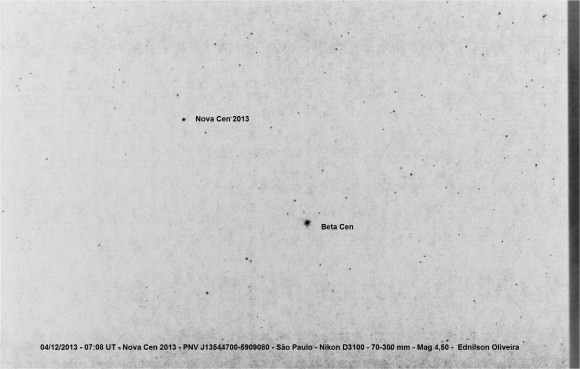
This is not to be confused with a supernova, the last of which observed in our galaxy was Kepler’s Supernova in 1604, just before the advent of the telescope in modern astronomy. Supernovae are seen in other galaxies all the time, but here at home, you could say we’re “due”.
So, who can see Nova Cen 2013, and who’s left out? Well, the coordinates for the nova are:
Right Ascension: 13 Hours 54’ 45”
Declination: -59°S 09’ 04”
That puts it deep in the southern celestial hemisphere sky where the constellation Centaurus meets up with the constellations of Circinus, Musca and the Crux. Located within three degrees of the +0.6th magnitude star Hadar — also named Beta Centauri — it would be possible to capture the southern deep sky objects of the Coal Sack and Omega Centauri with Nova Cen 2013 in the same wide field of view.
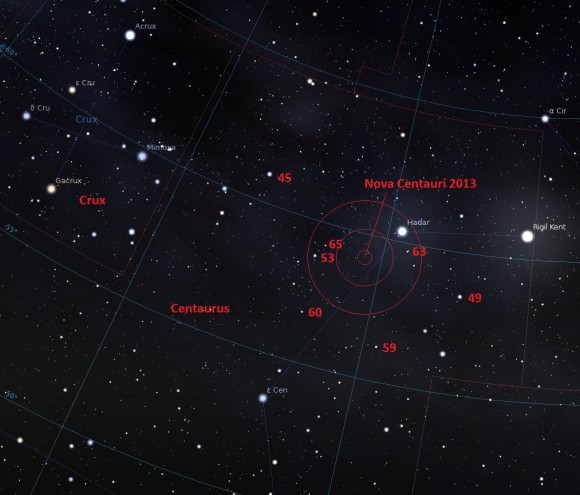
Though Nova Cen 2013 technically peeks above the southern horizon from the extreme southern United States, the viewing circumstances aren’t great. In fact, the nova only rises just before the Sun as seen from Miami in December, at 25 degrees north latitude. The Centaurus region is much better placed in northern hemisphere during the springtime, when many southern tier states can actually glimpse the celestial jewels that lie south, such as Omega Centauri.
But the situation gets better, the farther south you go. From Guayaquil, Ecuador just below the equator, the nova rises to the southeast at about 3 AM local, and sits 20 degrees above the horizon at sunrise.
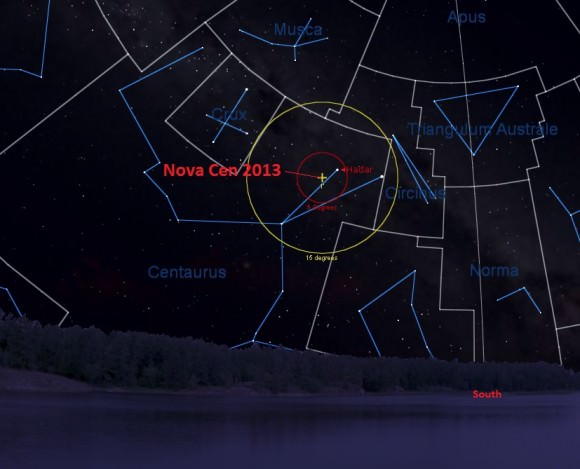
The nova will be circumpolar for observers south of -30 degrees latitude, including cities of Buenos Aires, Cape Town, Sydney and Auckland. Remember, its springtime currently in the southern hemisphere, as we head towards the solstice on December 21st and the start of southern hemisphere summer. We’ve been south of the equator about a half dozen times and it’s a unique experience – for northern star gazers, at least – to see familiar northern constellations such as Orion and Leo hang “upside down” as strange a wonderful new constellations beckon the eye to the south. Also, though the Sun still rises to the east, it transits to the north as you get deep into the southern hemisphere, a fun effect to note!
Latitudes, such as those on par with New Zealand, will get the best views of Nova Cen 2013. Based near latitude 40 degrees south, observers will see the nova about 10 degrees above the southern horizon at lower culmination at a few hour after sunset, headed towards 40 degrees above the southeastern horizon at sunrise.
All indications are that Nova Cen 2013 is a classical nova, a white dwarf star accreting matter from a binary companion until a new round of nuclear fusion occurs. Recurrent novae such as T Pyxidis or U Scorpii may erupt erratically in this fashion over the span of decades.
As of yet, there is no firm distance measurement for Nova Cen 2013, though radio observations with southern sky assets may pin it down. One northern hemisphere based program, known as the EVLA Nova Project, seeks to do just that.
Congrats to John Seach on his discovery, and if you find yourself under southern skies, be sure to check out this astrophysical wonder!
Got pics of Nova Centauri 2013? Be sure to send ‘em in to Universe Today!
Recurrent Novae, Light Echoes, and the Mystery of T Pyxidis
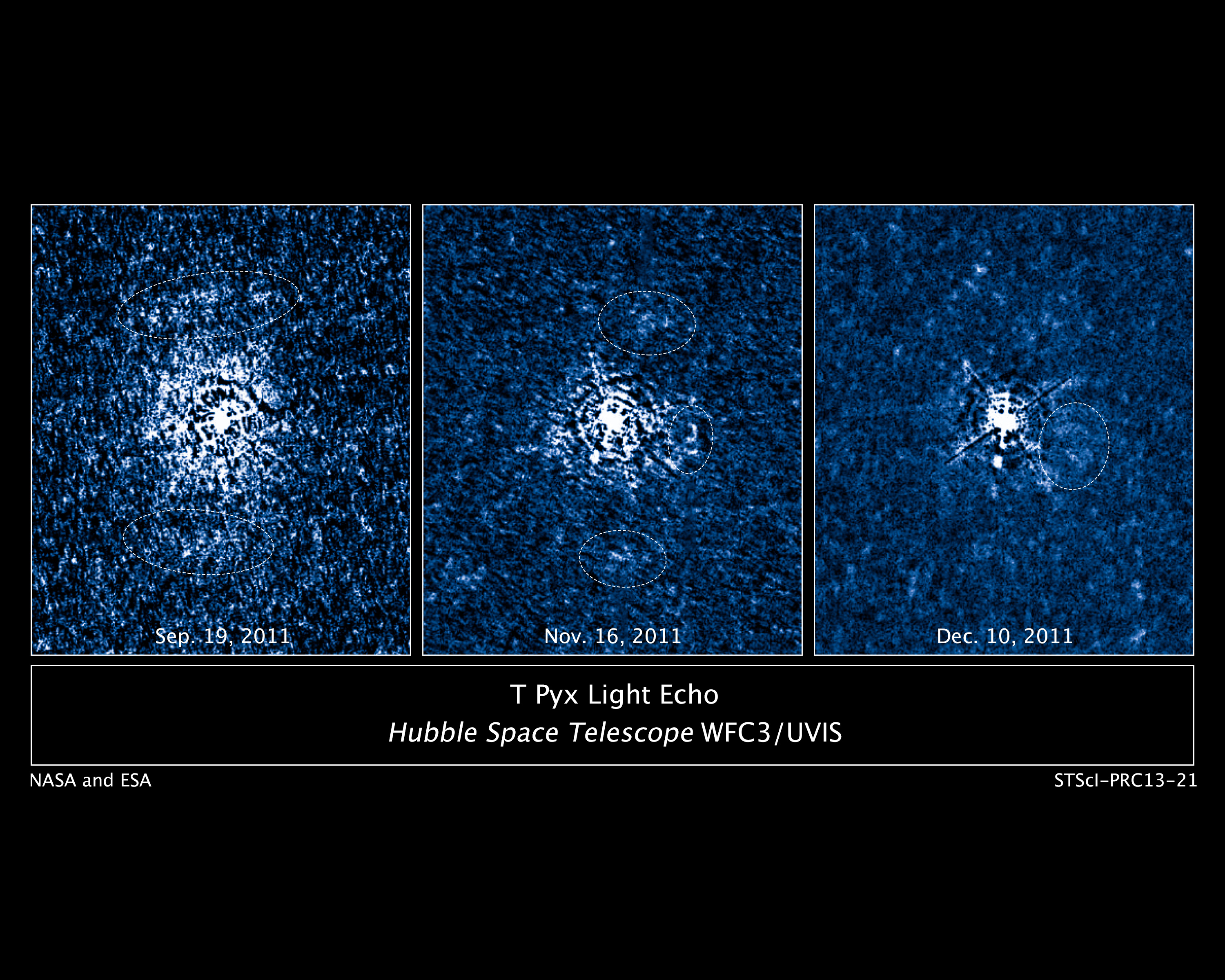
Some of the most violent events in our Universe were the topic of discussion this morning at the 222nd meeting of the American Astronomical Society in Indianapolis, Indiana as researchers revealed recent observations of light echoes seen as the result of stellar explosions.
A light echo occurs when we see dust and ejected material illuminated by a brilliant nova. A similar phenomenon results in what is termed as a reflection nebula. A star is said to go nova when a white dwarf star siphons off material from a companion star. This accumulated hydrogen builds up under terrific pressure, sparking a brief outburst of nuclear fusion.
A very special and rare case is a class of cataclysmic variables known as recurrent novae. Less than dozen of these types of stars are known of in our galaxy, and the most famous and bizarre case is that of T Pyxidis.
Located in the southern constellation of Pyxis, T Pyxidis generally hovers around +15th magnitude, a faint target even in a large backyard telescope. It has been prone, however, to great outbursts approaching naked eye brightness roughly every 20 years to magnitude +6.4. That’s a change in brightness almost 4,000-fold.
But the mystery has only deepened surrounding this star. Eight outbursts were monitored by astronomers from 1890 to 1966, and then… nothing. For decades, T Pyxidis was silent. Speculation shifted from when T Pyxidis would pop to why this star was suddenly undergoing a lengthy phase of silence.
Could models for recurrent novae be in need of an overhaul?
T Pyxidis finally answered astronomers’ questions in 2011, undergoing its first outburst in 45 years. And this time, they had the Hubble Space Telescope on hand to witness the event.
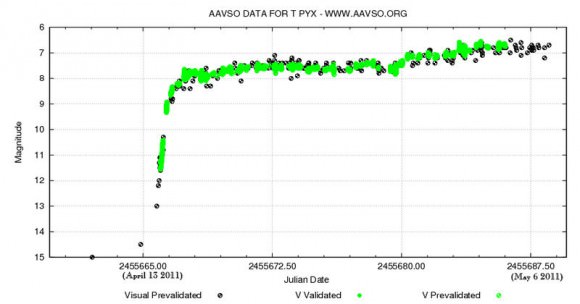
In fact, Hubble had just been refurbished during the final visit of the space shuttle Atlantis to the orbiting observatory in 2009 on STS-125 with the installation of its Wide Field Camera 3, which was used to monitor the outburst of T Pyxidis.
The Hubble observation of the light echo provided some surprises for astronomers as well.
“We fully expected this to be a spherical shell,” Said Columbia University’s Arlin Crotts, referring to the ejecta in the vicinity of the star. “This observation shows it is a disk, and it is populated with fast-moving ejecta from previous outbursts.”
Indeed, this discovery raises some exciting possibilities, such as providing researchers with the ability to map the anatomy of previous outbursts from the star as the light echo evolves and illuminates the 3-D interior of the disk like a Chinese lantern. The disk is inclined about 30 degrees to our line of sight, and researchers suggest that the companion star may play a role in the molding of its structure from a sphere into a disk. The disk of material surrounding T Pyxidis is huge, about 1 light year across. This results in an apparent ring diameter of 6 arc seconds (about 1/8th the apparent size of Jupiter at opposition) as seen from our Earthly vantage point.
Paradoxically, light echoes can appear to move at superluminal speeds. This illusion is a result of the geometry of the path that the light takes to reach the observer, crossing similar distances but arriving at different times.
And speaking of distance, measurement of the light echoes has given astronomers another surprise. T Pyxidis is located about 15,500 light years distant, at the higher 10% end of the previous 6,500-16,000 light year estimated range. This means that T Pyxidis is an intrinsically bright object, and its outbursts are even more energetic than thought.
Light echoes have been studied surrounding other novae, but this has been the first time that scientists have been able to map them extensively in 3 dimensions.
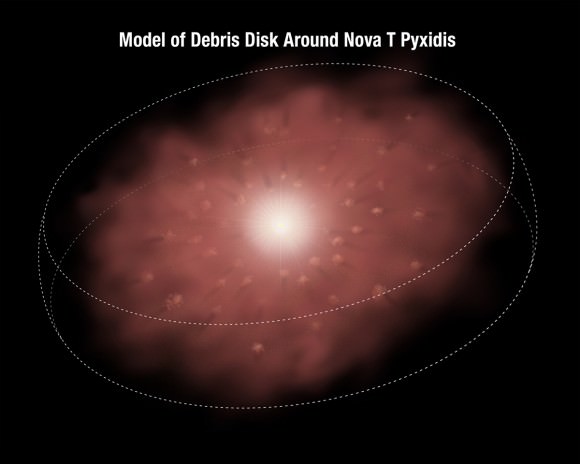
“We’ve all seen how light from fireworks shells during the grand finale will light up the smoke and soot from the shells earlier in the show,” said team member Stephen Lawrence of Hofstra University. “In an analogous way, we’re using light from T Pyx’s latest outburst and its propagation at the speed of light to dissect its fireworks displays from decades past.”
Researchers also told Universe Today of the role which amateur astronomers have played in monitoring these outbursts. Only so much “scope time” exists, very little of which can be allocated exclusively to the study of light echoes. Amateurs and members of the American Association of Variable Star Observers (AAVSO) are often the first to alert the pros that an outburst is underway. A famous example of this occurred in 2010, when Florida-based backyard observer Barbara Harris was the first to spot an outburst from recurrent novae U Scorpii.
And although T Pyxidis may now be dormant for the next few decades, there are several other recurrent novae worth continued scrutiny:
| Name | Max brightness | Right Ascension | Declination | Last Eruption | Period(years) |
| U Scorpii | +7.5 | 16H 22’ 31” | -17° 52’ 43” | 2010 | 10 |
| T Pyxidis | +6.4 | 9H 04’ 42” | -32° 22’ 48” | 2011 | 20 |
| RS Ophiuchi | +4.8 | 17H 50’ 13” | -6° 42’ 28” | 2006 | 10-20 |
| T Coronae Borealis | +2.5 | 15H 59’ 30” | 25° 55’ 13” | 1946 | 80? |
| WZ Sagittae | +7.0 | 20H 07’ 37” | +17° 42’ 15” | 2001 | 30 |
Clearly, recurrent novae have a tale to tell us of the role they play in the cosmos. Congrats to Lawrence and team on the discovery… keep an eye out from future fireworks from this rare class of star!
Read the original NASA press release and more on T Pyxidis here.


